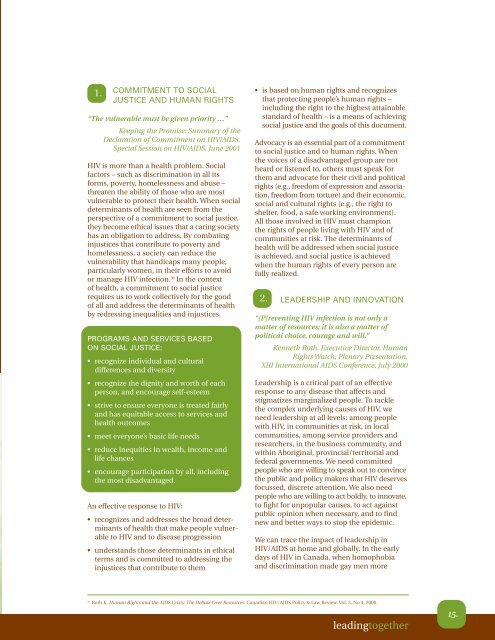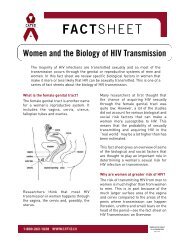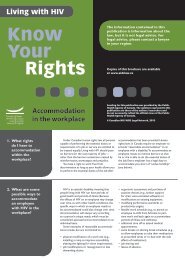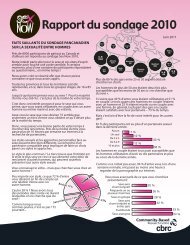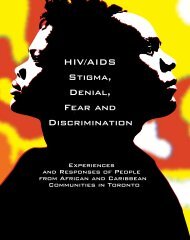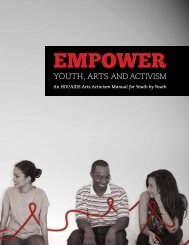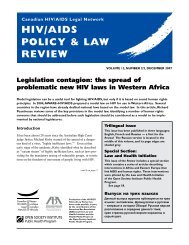leadingtogether: - CATIE
leadingtogether: - CATIE
leadingtogether: - CATIE
- No tags were found...
You also want an ePaper? Increase the reach of your titles
YUMPU automatically turns print PDFs into web optimized ePapers that Google loves.
1.COMMITMENT TO SOCIALJUSTICE AND HUMAN RIGHTS“The vulnerable must be given priority …”Keeping the Promise: Summary of theDeclaration of Commitment on HIV/AIDS,Special Session on HIV/AIDS, June 2001HIV is more than a health problem. Socialfactors – such as discrimination in all itsforms, poverty, homelessness and abuse –threaten the ability of those who are mostvulnerable to protect their health. When socialdeterminants of health are seen from theperspective of a commitment to social justice,they become ethical issues that a caring societyhas an obligation to address. By combatinginjustices that contribute to poverty andhomelessness, a society can reduce thevulnerability that handicaps many people,particularly women, in their efforts to avoidor manage HIV infection. 36 In the contextof health, a commitment to social justicerequires us to work collectively for the goodof all and address the determinants of healthby redressing inequalities and injustices.PROGRAMS AND SERVICES BASEDON SOCIAL JUSTICE:• recognize individual and culturaldifferences and diversity• recognize the dignity and worth of eachperson, and encourage self-esteem• strive to ensure everyone is treated fairlyand has equitable access to services andhealth outcomes• meet everyone’s basic life needs• reduce inequities in wealth, income andlife chances• encourage participation by all, includingthe most disadvantaged.An effective response to HIV:• recognizes and addresses the broad determinantsof health that make people vulnerableto HIV and to disease progression• understands those determinants in ethicalterms and is committed to addressing theinjustices that contribute to them• is based on human rights and recognizesthat protecting people’s human rights –including the right to the highest attainablestandard of health – is a means of achievingsocial justice and the goals of this document.Advocacy is an essential part of a commitmentto social justice and to human rights. Whenthe voices of a disadvantaged group are notheard or listened to, others must speak forthem and advocate for their civil and politicalrights (e.g., freedom of expression and association,freedom from torture) and their economic,social and cultural rights (e.g., the right toshelter, food, a safe working environment).All those involved in HIV must championthe rights of people living with HIV and ofcommunities at risk. The determinants ofhealth will be addressed when social justiceis achieved, and social justice is achievedwhen the human rights of every person arefully realized.2.LEADERSHIP AND INNOVATION“[P]reventing HIV infection is not only amatter of resources; it is also a matter ofpolitical choice, courage and will.”Kenneth Roth, Executive Director, HumanRights Watch, Plenary Presentation,XIII International AIDS Conference, July 2000Leadership is a critical part of an effectiveresponse to any disease that affects andstigmatizes marginalized people. To tacklethe complex underlying causes of HIV, weneed leadership at all levels: among peoplewith HIV, in communities at risk, in localcommunities, among service providers andresearchers, in the business community, andwithin Aboriginal, provincial/territorial andfederal governments. We need committedpeople who are willing to speak out to convincethe public and policy makers that HIV deservesfocussed, discrete attention. We also needpeople who are willing to act boldly, to innovate,to fight for unpopular causes, to act againstpublic opinion when necessary, and to findnew and better ways to stop the epidemic.We can trace the impact of leadership inHIV/AIDS at home and globally. In the earlydays of HIV in Canada, when homophobiaand discrimination made gay men more36Roth K. Human Rights and the AIDS Crisis: The Debate Over Resources. Canadian HIV/AIDS Policy & Law Review. Vol. 5, No 4, 2000.<strong>leadingtogether</strong>15.


